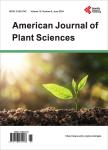Potential Use of Tropical Grass for Deferment in Semi-Arid Region
Potential Use of Tropical Grass for Deferment in Semi-Arid Region作者机构:Animal Science Department Federal University of Ceará Fortaleza Brazil Division of Forage and Soil Science Embrapa Goats and Sheep Sobral Brazil
出 版 物:《American Journal of Plant Sciences》 (美国植物学期刊(英文))
年 卷 期:2014年第5卷第7期
页 面:907-914页
学科分类:1002[医学-临床医学] 100214[医学-肿瘤学] 10[医学]
主 题:Enriched Caatinga Crude Protein Digestibility Pasture Quality Guineagrass Panicum maximum cv. Massai
摘 要:Management evaluation of Panicum maximum cv. massai (Massai guineagrass) under deferment contributes as a strategic reserve of forage in the Brazilian semi-arid region. The objective of this study was to evaluate biomass production and nutritive value of massai guineagrass in an area of thinned caatinga vegetation in two deferment periods (60 and 90 days after plot-leveling cut) and four use periods (30, 60, 90 and 120 days after the end of the rain season), in a random blocks design arranged in a split-plot (2 × 4), with three replications. Extending the deferment period of massai guineagrass promoted elevation of the biomass components, but compromised the pasture quality due to increasing stem biomass. The massai guineagrass deferred 30 days after raining season started and should use 90 days after raining season ended to ensure a forage supply of appropriate nutritional value. The increase in relative air humidity and the occurrence of rainfall after water restriction stimulate regrowth, resulting in improved nutritional value of the grass.



